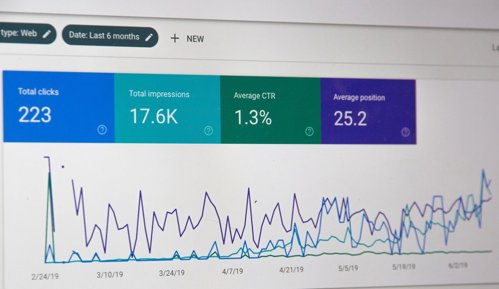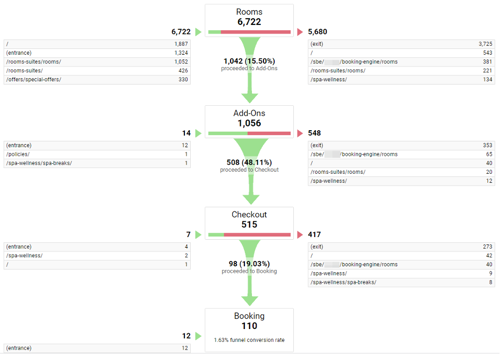Google Analytics - best practices for hotels
Making your hotel marketing budget work effectively for you is challenging, and never more so than in the current pandemic climate. Tracking your website performance and digital marketing activities with resources like Google Analytics can uncover insight to help you make actionable changes.

Making your hotel marketing budget work effectively for you is challenging, and never more so than in the current pandemic climate, when uncertainty is plentiful and funds are under pressure. Tracking your website performance and digital marketing activities with resources like Google Analytics can uncover insight to help you make actionable changes.
Although learning Google Analytics is not an overnight process, it is an extremely useful tool to have at your disposal and will help you understand how visitors are getting to your website, which channels are working best and revealing what actions visitors are taking while there.
We asked one of the 80 DAYS team to share their top 5 best practices to help you get the most from your Google Analytics account.
SETTING UP GOALS: TRACKING KPIS
It is important for a hotel marketing team to set clear objectives around what you would like to achieve on your website, only then will you be in a position to set goals and track KPI’s, so consider it a three-stage process.
- First agree your objectives. These could be obvious objectives such as increasing room bookings or driving more wedding enquiries. Each objective should then be broken down into a number of smaller objectives. Using the example of increasing wedding enquiries, smaller objectives might include increasing downloads of your wedding brochure or increasing the number of wedding enquiry forms submitted on-line.
- Goals are the actions you want visitors to take on your website, and will underpin the smaller objectives like number of wedding enquiry forms submitted on-line. These goals are what is tracked and can be set up in the admin section of your Google Analytics account.
- Once you have set up your goals – set realistic KPI’s for every goal, using our same example, you may want to increase the number of wedding enquiry forms submitted on-line from 10 to 15 each month.
SETTING UP A BOOKING FUNNEL GOAL
The booking/conversion funnel is arguably the most important part of a hotel’s website. It’s where you can turn a visitor into a customer, but comparison shopping, slow page loading times, and onerous data fields are all reasons you could be losing customers. Historically some guesswork might have been involved in trying to uncover causes, but by setting up a booking funnel goal, you can isolate potential pitfalls in the booking process.
Before you outline your booking funnel in Google Analytics, you have to identify the steps visitors will take to convert on your hotel website. You then have to show Google Analytics this same path – this is the booking funnel and it is made up funnel steps and the goal page – a ‘destination’ goal. This means setting a specific web page as the goal that you want to measure every time a visitor lands there. This is the last page your visitors end up for a confirmed booking. In your Google Analytics account you might call this new goal ‘confirmed bookings’. Select Destination as Type. In the Destination field you will need to enter the URL of the last page visitors end up for a ‘confirmed booking’ and once you have turned the Funnel slider on you will be able to see the part of Google Analytics where you need to enter the individual URL’s of each step in the path. You should give each step a name and assign the corresponding URL.

Remember to verify the new goal and save it, and you can then begin tracking and more importantly analysing your booking funnel moving forward to understand where your visitors are dropping out of the booking funnel.
USING GOOGLE TAG MANAGER
If you are not familiar with Google Tag Manager or not already using it within your Google Analytics Account, it’s a change that you should think about making sooner than later. Google Tag Manager is a tool that allows you to manage and arrange marketing tags or in more technical terms – snippets of code or tracking pixels (e.g. Facebook) on your website or mobile app without having to change code or more importantly requiring a developers support. Theoretically, using Google Tag Manager means it’s easier for a hotel’s marketing teams to manage the various tags that exist on a hotel website within one platform, and when they are running from one location, your website code should be cleaner and theoretically page load times faster – helping with SEO.
SETTING UP TRACKING FOR ALL HOTEL SERVICES
Your tracking doesn’t need to stop at room or accommodation bookings.
Google Tag Manager and the powerful tags that it supports means e-commerce and event tracking can be setup directly from within Tag Manager for any number of hotel services, for example; golf tee time bookings, gift voucher tracking, spa reservations, table bookings etc. as long as the service provider's platform supports it. This would also allow you to add to e.g. add a Facebook pixel to your gift voucher platform to measure the success of your Facebook Black Friday gift voucher campaign. Your service provider's platform may have limitations as to where only Google Analytics code can be added, in which case you would need to send them any tracking pixels separately.
We would also recommend setting up separate 'Views' in Google Analytics for each hotel service. This would allow you to easily see the performance of each individual service.
SETTING UP CUSTOM DIMENSIONS ON THE BOOKING ENGINE
If you would like to measure the characteristic of a visitor that cannot be measured by any of the default dimensions (e.g. channels, page, country) available in Google Analytics, you can create your own custom dimension. These would work with your metrics e.g. sessions, users and transactions. These custom dimensions can provide additional data that Google Analytics does not automatically track e.g. booking dates, days to check-in, number of rooms and adults selected on the booking engine.
Once these custom dimensions are set up, you can:-
- Create custom reports in Google Analytics or using Google's reporting tool Data Studio to combine these new custom dimensions with metrics. For example, you could create a booking window report using the days to check-in custom dimension and see what days perform best in terms of number of transactions and conversion rate.
- Create custom audiences such as couples and families, or users looking to book for a specific month. Importing these audiences into Google Ads would then allow you to retarget these users with offers relevant to them.
If you need support in setting up Google Analytics or Google Tag Manager, please get in touch with one of the team at our sister company 80 DAYS to discuss their comprehensive Analytics consultancy services. The team are Google Analytics certified and experts at both the setup and debugging of hotel website tracking.
Categories:
Edward Janson has been working at 80 DAYS for 5 years, is Google Analytics qualified and a Google Tag Manager expert.


